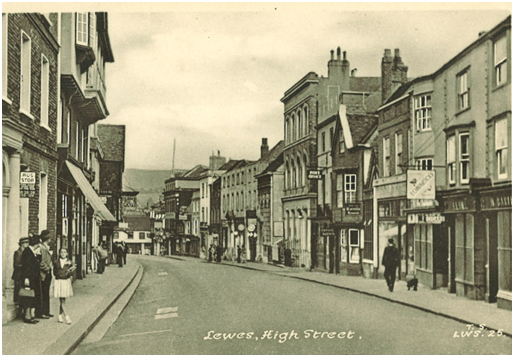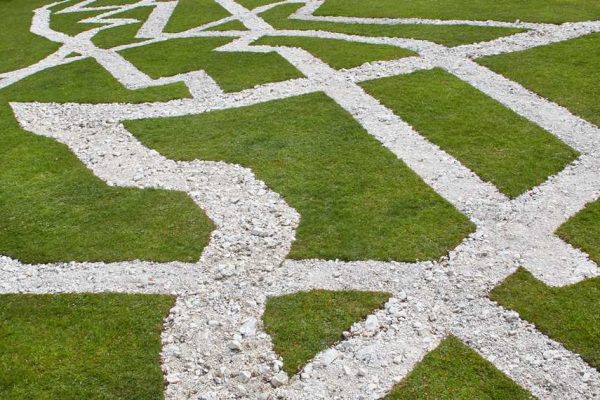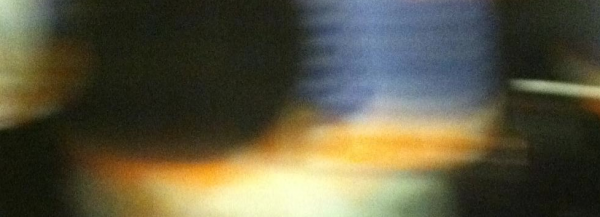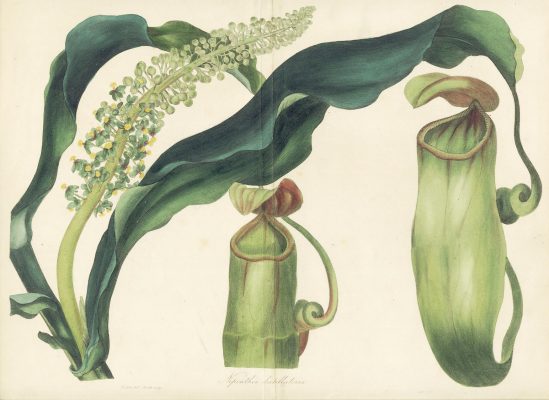‘So I turned around for an instant to look at what my field of vision onto the sea had not offered up: the heavy grey mass where traces of planks lined up along the inclined ramp like a tiny staircase. I got up and decided to have a look around this fortification as if I had seen it for the first time, with its embrasure flush with the sand, behind the protective screen, looking out onto the Breton port, aiming today at inoffensive bathers, its rear defence with a staggered entrance and its dark interior in the blinding light of the gun’s opening toward the sea.’ – Paul Virilio, Bunker Archaeology
It is October 2010 and I am in the kitchen of an old house in Sussex. From the kitchen, a door leads to the hallway. Suddenly the door begins to sway from side to side. At first, I think nothing of it and put it down to a breeze from another room. But then the swaying became more deliberate, as if a presence were trying to communicate from afar. The door moves to one end, pauses for a second, and then proceeds to return to the other side. To and fro it moves, until suddenly, and without warning, it stops. As I stand to investigate, an iridescent light fills the hallway, and a tall silhouette clad in black slowly crosses the landing before disappearing into the brick wall. In response, the skin on my body becomes clammy with anxiety, while the hairs beginning at the base of my head and extending to the lower reach of my neck recoil, as if they had grasped some kind of horror that I was still in the process of experiencing. One minute later, I am on the street.
Disturbed by the vision, I look at the house from the vantage point of the outside. If the figure has come to me in a moment of private intimacy, then I am sure it would not follow me down the stairs and onto the other side of the street, and thereby expose itself to the public gaze. On the contrary, I am fairly convinced it is still inside, likely oscillating between the landing on the hallway and the kitchen, where – so I assume – it may have once encountered some kind of trauma that led it to being affixed to this place in time.
How many other people had seen the figure since the conception of the house in the fifteenth century? Numerous people no doubt through the centuries, each of whom will have had their own story to tell. In addition, all of these people will have had their own interpretation of the figure, from the seventeenth century interpretation of spectres as restorers of social injustices of the living to the nineteenth century interpretation of the such sights as a figure of death that refuses to die, thus offering hope that in an increasingly secularised age, life after death remains possible.
70 High Street is at the right of this photo, just next to the man walking the dog
In all this, I may well form part of a historical community that will have encountered this vision in this particular place, 70 High Street, Lewes, Sussex. What did the figure want from us all: to testify to its mournful existence, to become its voice, or simply in the act of affecting another person, to remind itself that it still holds the power to form an alliance with the living? And why did it choose us? Are we in some sense more receptive to the troubled dreams of those who refuse to die than other people? Did the figure sense an anxiety within each of us that renders our senses more attuned to ambiguous forms of life?
***
What is a ghost? The question has gained a particular value in the last decade or so owing to the influence of Derrida’s concept of hauntology, a pun on ontology referring to the spectre of Marxism. As it is understood in a post-Derridean context, the concept refers to a broad range of cultural phenomenon characterised, above all, by a certain collapse in the spatio-temporal order, signalling the radical collision of old and new. It is a Ballardian vision of time, in which the end has already occurred and we are now – perhaps unknowingly – living in its shadow.
The term figures in a variety of mediums, from the archival restoration of ‘abandonware’ and ‘dead tech’, to the music of both Caretaker and the retro pastiche of Belbury Poly together with the associated Ghost Box Music label. In films, the theme is evident in works such as Peter Weir’s Picnic at Hanging Rock (1975) and Nic Roeg’s Don’t Look Now (1973). Alongside these mediums, the image of the urban ruin being reclaimed by wild mangroves, the drained swimming pool of an abandoned hotel, and the decommissioned remains of war bunkers would all be central motifs for the hauntologist. In each of these forms, the hauntological aesthetic plays out in terms of an appeal to the uncanny: that is, to the re-emergence of what was originally repressed, but only now—through an accidental rupture in the present – comes to light. Such an aesthetic has its roots in Freud, and can then be mapped out in the work of surrealists and their usage of anachronism, before then resurfacing in Walter Benjamin’s philosophy of history, which will later re-appear once more in the works of W. G. Sebald, and in a contemporary guise, in artists such as Cyprien Gaillard and Gregory Chatonsky.
Today, there is a danger that the theoretical treatment of hauntology has become academically and culturally canonised, and therefore rendered sterile. Indeed, increasingly the term is marked less by a critical interrogation of the past and more with an uncritical if not sentimental affirmation of a certain type of obsolete culture and sensibility that has its roots in 1970s British and to a lesser extent North American media. Into this framework, the category of the ghost has assumed a significant role. But only now, the presence of the ghost plays a metaphorical role, not as an actual spectre of the undead, but as a device that enables the voice of the overlooked past to finally be heard. It is an aesthetic of liberation, therefore, aligned with an admirable political orientation, but which is less at the service of the ghost itself and more the voice the ghost speaks through.
***
Were we to employ hauntology as means of understanding what a ghost is, then we would fall short of achieving our goal. If the theoretical model provides ghost hunters with the means of accessing the underside of a politically structured society, then it leaves us little insight into the nature of the ghost itself. Against hauntology, let us turn in the diametrically opposite direction: cognitive neuroscience.
For a neuroscientist such as Peter Brugger, the ghost has its place, not in the ruined castles of a childhood memory, nor even in the dank alleyways hidden within cities at night, but in the brain itself. What is a ghost? For Brugger, it is reducible to a tendency in visual perception to identify order within an arbitrary configuration.[1] Brugger turns to the example of August Strindberg’s visions, as they figure in his From an Occult Diary. Brugger presents us with an overview of Strindberg’s ‘apophenic reactions’ to random patterns. Of configurations in clouds, Strindberg ‘sees the form of a hind in the clouds and believes the nodding of her head is a special sign’. Likewise, when confronted with sticks in a box, Strindberg reports the following: ‘I opened an enormous chest, empty except for five sticks, painted black. What they were intended for I did not know, but they were arranged on the bottom of the chest to form a pentagram. Who has played this trick on me and what does it mean?’
Brugger’s response to these sightings is to align them with a schizophrenic propensity to overproduce meaning in things, an act that is as much dependent on apophenia as it is an urge to create. This ‘borderland of creativity’ can be explained in terms of what Brugger terms a ‘disinhibition of associative processes’. By this, Brugger refers to the tendency characterising schizophrenic patients to link words with incongruent associations. In the manner of Andre Breton’s psychic automatism, the schizophrenic or Strindbergian perspective is purportedly no stranger than an exaggerated version of aligning red with danger or similarly associating green with the motion of speeding up. In turn, this model can also explain paranormal phenomena such as ghosts, especially, so Brugger writes, ‘if the target words are exposed to the subject’s left visual field’.
What is important for Brugger about the phenomena of hauntings is not the content of the hauntings themselves, but what these experiences can reveal about the cognitive structure of the brain. If the hauntological treatment of the ghost treats the phenomena in no more than figurative terms, then in Brugger’s diametrically opposed framework, the ghost becomes a sort of error in perception that ultimately science, in its research on electrophysiology and electroencephalography, will one day be able to explain fully. And yet far from leading us closer to the ghost, this scientific reduction instead abstracts the ghost from its place of haunting and deprives it of all but a strictly cognitive meaning.
To return to Strindberg. Tellingly, one of his apophenic reactions is to a crumpled pillow. There, Strindberg reports the following interpretation: ‘…I once found my pillow, which I had crumpled when taking my midday rest, so moulded that it looked like a marble head in the style of Michelangelo… These occurrences could not be regarded as accidental, for on some days the pillow presented the appearance of horrible monsters, of gothic gargoyles, of dragons, and one night… I was greeted by the Evil One himself.’
As lovers of ghost tales know too well, the image of crumpled linen is one that haunts the imagination of ghost writers. Most obviously, it plays an especially important role in the venerated story by historian and academic, M. R. James, ‘Oh, Whistle, and I’ll Come To You My Lad’. In the story, a Cambridge don, Professor Parkins, is on holiday in a seaside resort on the Suffolk coastline. On a walk along a cliff edge, he encounters a discarded whistle engraved with the words, Quis est iste qui venit (‘Who is this who is coming?’). In response to the question, the Professor blows the whistle. That night, he is kept awake by the noise of wind accompanied by a vision. On the beach, the Professor sees a distant object:
Rapidly growing larger, it, too, declared itself as a figure in pale, fluttering draperies, ill-defined. There was something about its motion which made Parkins very unwilling to see it at close quarters. It would stop, raise arms, bow itself toward the sand, then run stooping across the beach to the water-edge and back again; and then, rising upright, once more continue its course forward at a speed that was startling and terrifying.[2]
Yet again, the following night, the figure on the beach comes closer, this time into the Professor’s room itself. It begins with a rustling noise, and then a ‘figure suddenly [sat] up in what he had known was an empty bed’. Leaping from his bed, the apparition advances toward him with arms outstretched, ‘Now it began to move, in a stooping posture, and all at once the spectator realised, with some horror and some relief, that it must be blind, for it seemed to feel about it with its muffled arms in a groping and random fashion.’ As the spectre moves into the light of a full moon, it reveals itself for what it is: ‘an intensely horrible, face of crumpled linen’. The story ends with Professor Parkins, hitherto a man of logic and rigour, in a state of nervous collapse, with his rational views ‘on certain points…less clear cut than they used to be’.
James’s story signals the collapse of reason and imagination, and thus plays to both the cultural (hauntological) and scientific (reductive) account of ghosts. In the case of the former theory, the past refuses to remain buried but instead finds its expression in the chance encounter of an old whistle on the edge of a cliff. This collision of fate and chance serves to inadvertently summon a past that was there all along, only dormant.
Exemplary of the logic of hauntology,M. R. James draws together a constellation of different eras in the same figure; namely, the figure of the spectre emerging from the sand on the Suffolk coastline, a coastline that – significantly – was the haunting ground of another ghost collector: W. G. Sebald. The gesture of imbuing an otherwise placid landscape with the phantoms of antiquity is central to hauntology. Only in the case of hauntology, the past is not a remote one but instead a time that has been compressed, dating back a mere no more than thirty or forty years – that is, largely to the childhood of those who assign their own past as the site of a haunting.
The conclusion of James’s story points to the insufficiency of a reductive account of ghosts. The image of the Professor in a state of collapse, his rational foundations broken by the rupture of an anachronic timescale, in which the existence of a ghost materialising from crumpled linen becomes a tenable reality, is enough to undermine the scientific account of the ghost as simply being an epistemic error in perception. Something more than cognitive processes must be accounted for if we are to address the role both science and culture can play in shaping the ghost.
***
Once more, I am standing outside of 70 High Street, Lewes. The figure in black who crossed the landing before disappearing into the brickwork is nowhere to be seen, save that of a memory that from time to time I might again experience in my body. In the moonlight, the house reveals itself in a partial glimpse. The place has a life of its own, quite apart from the manner in which it is experienced by me. And yet, without the living, there are no ghosts. If the ghost of a place resists the category of cultural symbol and is equally ill-at-ease in being a fault or excess in perception, then this does not mean it inhabits the mind alone, therefore denying its reality in the external world. Rather, something takes place between the viewer and the spectre that renders the dialogue between the living and the semi-living possible. This ambiguity is inherent in our relationship with places, be it in the ruins of an abandoned fort or in the harshly lit tunnels of a subway station at night. In each case, the genius loci reveals itself as precisely that which resists our understanding and instead constitutes a place as both the site of a haunting but also the haunt to which we return time and again.
[1] Peter Brugger, ‘From Haunted Brain to Haunted Science: A Cognitive Neuroscience View of Paranormal and Pseudoscientific Thought’, Hauntings and Poltergeists: Multidisciplinary Perspectives, edited by J. Houran and R. Lange (North Carolina: McFarland & Company, Inc. Publishers, 2001)
[2] M. R. James, Collected Ghost Stories (Hertfordshire: Wordsworth Books, 2007).





